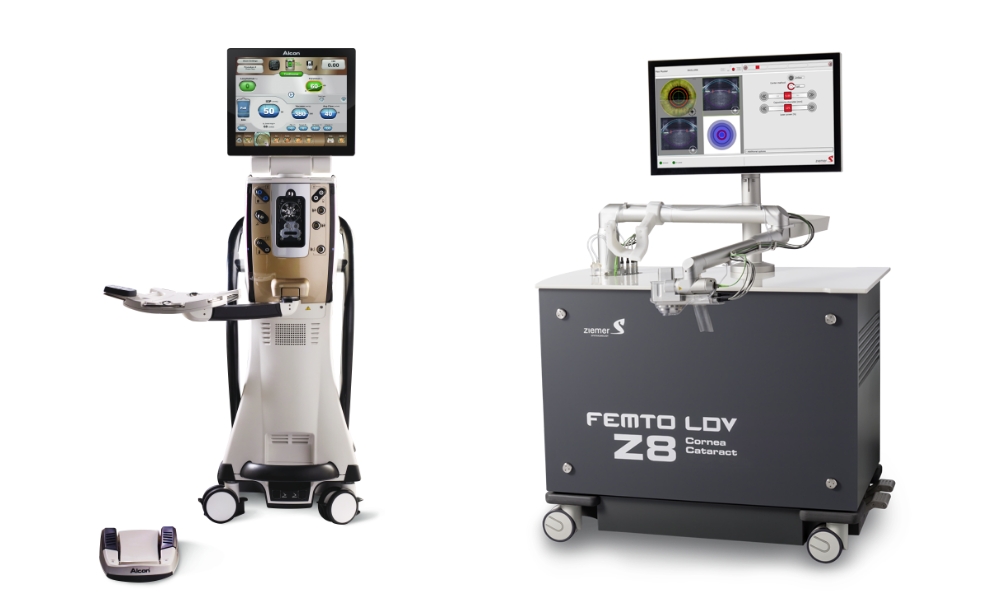Advanced skills and cutting-edge instruments minimize patient discomfort
Laser cataract surgery
Cataracts are the leading cause of blindness.
Cataract refers to clouding of the lens that permits light to pass and form an image on the retina. When the lens becomes cloudy, it prevents light from passing through properly, resulting in blurry vision that resembles fog. This results in a variety of vision disorders such as impaired vision, glare, and vision overlap. Cataracts are most commonly caused by aging, but they can also be brought on by trauma, diabetes, inflammation, or drugs. Worldwide, cataracts (51%), glaucoma (8%) and macular degeneration (5%) are cited as the leading causes of blindness.
Safe laser treatment for cataracts with minimal side effects
In the early stages of cataracts, eye drops or medications may slow the progression of the condition, but medication alone cannot clear the cloudy lens. If you experience significant daily inconvenience, surgery can be performed to remove the cloudy lens and replace it with an artificial lens. Conventional cataract surgery was manually performed by medical personnel. To remove the lens, the cornea and inner capsule were manually incised, followed by emulsification and aspiration of the lens. This technique significantly irritates the surgical site, increases the risk of complications, and has a significant impact on the surgical outcome, depending on the skill of the surgical team. Recently, laser cataract surgery has been performed, enhancing surgical precision and minimizing patient complications by shortening the duration of the procedure. In laser cataract surgery, 3D eye analysis diagnostic equipment is used to precisely analyze different lens sizes, tilts, and cataract density for each individual patient, and the surgery is 1:1 customized based on biometric information. By customizing the space for the surgical instrument to the patient's eye condition, tissue damage is minimized, thereby reducing pain and accelerating recovery. Even at the stage of emulsifying and aspirating the lens, the laser can separate the lens into several pieces before removing it, allowing the intraocular lens to be firmly positioned without causing irritation to the surrounding tissue. The greatest benefit of laser cataract surgery is that it shortens the duration of the operation. The recovery time is proportional to the duration of the operation, and the larger the incision, the greater the likelihood of adverse effects and complications. Laser surgery enables the procedure to be performed precisely and safely.
4 Advantages of Laser Cataract Surgery
The FEMTO LDV Z8 laser, which is used for cataract surgery at Boda Eye Clinic, employs a high-frequency and low-energy laser that is 100 times faster than conventional lasers, which not only shortens the duration of the operation but also enables complex surgery. In addition, three-dimensional images of the eye obtained using OCT (Optical Coherence Tomography) prior to surgery is allows for precise irradiation of the laser, thereby reducing variables and potential complications during surgery and significantly increasing safety. 'Centurion,' the latest surgical equipment from ALCON, the world's largest ophthalmic equipment manufacturer, features the world's first intraocular pressure maintenance function to maintain proper intraocular pressure to minimize patient pain during surgery and risk by preventing repulsion in the eye and temperature rise in the corneal incision.
There are four major benefits associated with cataract surgery at the Boda Eye Clinic, which utilizes cutting-edge technology and seasoned medical personnel. First, you will not experience any pain or discomfort before or after surgery. Before cataract surgery, eye drop anesthesia is used, and there is no pain before or after anesthesia because the surgery is performed after administering eye drops 2-3 times without injecting anesthetic around the eyes. Second, natural and safe healing is possible without the need for sutures. Due to the advancement of soft intraocular lenses, it is now possible to insert an intraocular lens even through a small incision, allowing for natural healing without the use of sutures after insertion. Third, because the operation is performed through a 2.75mm incision using ultrasound, the operation time is reduced to 15 minutes and the patient can be discharged without hospitalization. Because only a small incision is made, complications are minimized, and the operation proceeds without bleeding because the cornea is incised in areas without blood vessels.
Cataracts, the leading cause of blindness, can be slowed down with regular check-ups, nutritional supplements, and management before onset. Cataracts that have progressed as a result of aging, on the other hand, require appropriate surgery and treatment before they cause more serious debilitating effects. Boda Eye Clinic, a medical facility in Daejeon that caters to foreign patients, deploys cutting-edge technology and skilled medical staff to help patients recover quickly while minimizing inconvenience.





 Specialized Medical Service
Specialized Medical Service
 Bio Technology
Bio Technology
 Health & Wellness
Health & Wellness
 City & Culture
City & Culture
 Hot Issue
Hot Issue
 Interview With
Interview With
 Medical Technology
Medical Technology
 City & Culture
City & Culture
 Food & Travel
Food & Travel
 Health & Wellness Tips
Health & Wellness Tips
 Hot Issue
Hot Issue